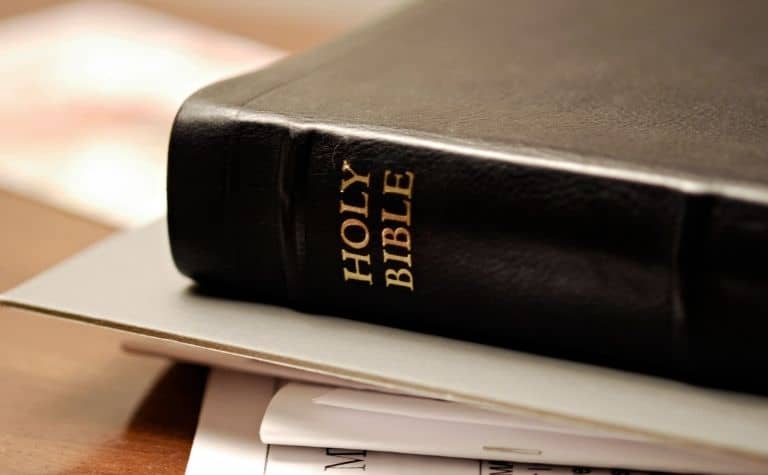Non-denominational churches are becoming popular as many conservative Christians become disenfranchised with mainline denominations. Non-denominational churches tend to be Protestant, conservative, and evangelical. As conservative evangelicals, non-denominational churches have a high view of the Bible.
Non-denominational churches use Bible translations such as the New International Version (NIV), the English Standard Version (ESV), the New American Standard (NASB), the King James Version (KJV), the New King James (NKJV), and the New Living Bible (NLT). Other accurate, readable translations may be read as well.
Why don’t non-denominational churches use the same Bible translation? How do people who attend non-denominational churches select a translation to read? What is the difference between the NIV, ESV, NASB, KJV, NKJV, and NLT translations? Keep reading to learn more.
Also, see Non-Denominational vs. Protestant: Differences to learn more.

Why Don’t Non-Denominational Churches Use the Same Bible Translation?
Non-denominational churches aren’t associated with traditional Protestant denominations like Baptist, Lutheran, Presbyterian, Methodist, Episcopalian, or the Assemblies of God.
People who plant non-denominational churches often benefit from not partnering with an established denomination. (Also see Evangelical vs. Non-Denominational: What’s the Difference?)
However, non-denominational churches borrow from traditional denominations. For example, the vast majority are theologically Protestant and trace their doctrinal heritage to Martin Luther (1483-1546), the founder of Lutheranism, as all Protestant traditions do.
Also, most non-denominational churches don’t baptize infants, just adults, as Baptist denominations do. Some speak in tongues like Assemblies of God churches do.
Non-denominational churches aren’t connected to an established denomination, but they are disconnected from each other as well. “Non-denominational” isn’t a network or association of churches that are in relationship with one another.
Each non-denominational church operates independently. They hire their own pastor, create their own membership rules, write their own constitution and by-laws, and register with the civil authorities as a non-profit organization. (Also see Non-Denominational vs. Catholic: What’s the Difference?)
The autonomy of each non-denominational church means no uniform Bible translation among them. Even within a non-denominational church, the pastor and church leaders don’t dictate what version of the Bible people read.
Leadership often encourages people to read an accurate and understandable translation, which is why Bible versions like the NIV, ESV, NASB, KJV, NKJV, and NLT are so popular.

How Do Non-Denominational Church Members Select a Translation?
Bible readers, especially those new to it, sometimes aren’t aware that there are different translations. People get Bibles as gifts, or their church gives them one, and they start reading it. (Also see Do All Christian Denominations Use the Same Bible Translation?)
It’s not uncommon for someone who is asked — “What Bible translation do you read?” — to look at the spine of the book of the first few pages to look for the initials or name of the translation.
While this is generally not harmful, there is wisdom in a person knowing what Bible translation they are reading to ensure it’s accurate and the right one for them (more below).
People select a translation in different ways. Here are common ways people make their choice:
- They use whatever translation their pastor uses. Churchgoers trust their pastor, so it’s easy to read whatever translation he does. It also makes it easier to follow along when he is preaching. This is often a good way to select a Bible translation because a pastor will often pick an accurate translation but also one that most can understand.
- They use whatever translation their Sunday school class or small group uses. Like people who trust their pastor, they also trust their close relationships with other believers. Many churches show Bible verses on a big screen when the pastor is preaching, so it’s not necessary to use the same translation he does. If this is the case, some people will use a translation that others in their Bible study read.
- They use a translation that emphasizes accuracy. Because of how words, thoughts, and sentences get translated from one language into another, the more accurate a translation is, the less “readable” it becomes. “Readability” is a term that refers to how easy a translation is to read or understand. The most accurate Bible translations have a high reading level, like the 11th or 12th grade (see chart below).
- They use a translation that emphasizes readability. The more accurate a translation is, the less readable, and vice versa. Referring to a translation as less accurate doesn’t mean it’s untrustworthy. “Readability” is a reference to its reading level. For example, the NASB and the KJV are highly accurate concerning the original languages of Scripture and measure at an 11th or 12th-grade reading level. The NIV and NLT are highly readable and register a 6th to 8th-grade reading level (see chart below).
Accuracy and readability are terms used to describe the reading level of trustworthy Bible translations. People who don’t read well or aren’t used to reading the Bible may opt for a highly readable translation.
Those who benefit from in-depth study and enjoy researching the meaning of biblical words, for example, may opt for a translation that emphasizes accuracy.
Also, see Can You Be a Christian Without a Denomination?

What Is the Difference Between the NIV, ESV, NASB, KJV, NKJV, and the NLT?
The comparison chart below offers readers an overview of popular Bible translations used in denominational and non-denominational Christian churches. Each translation has a unique history, a translation methodology, and a measurable reading level.
| Translation | History | Methodology | Reading Level |
|---|---|---|---|
| NIV | The full text of the New International Version (NIV) appeared in 1978. Over 40 years later, the NIV maintains a wide readership, especially among conservative evangelicals. | Thought-for-thought; the meaning of each thought, not necessarily each word, is the aim of translators | 7th grade |
| ESV | Published in 2001, the English Standard Version (ESV) reworks the Revised Standard Version (RSV), which first appeared in 1971. Conservative evangelical scholars produced the ESV, so it’s not a surprise that it has been growing in popularity among conservative evangelical readers in the last two decades. | word-for-word (“essentially literal”) | 8th grade |
| NASB | The New American Standard Bible (NASB) Update appeared in 1995 with the purpose of improving the translation’s clarity and updating outdated English styles (e.g., removing words like “thou”). Since its first appearance in 1971, the NASB has been a favorite among people who prefer a word-for-word translation. | word-for-word (“strictly literal”); also known as “formal equivalence” | 11th grade |
| KJV | The King James Version first appeared in 1611, then underwent several revisions in the following centuries. The KJV is the most popular English translation in Protestant history. | word-for-word (“essentially literal”) | 12th grade |
| NKJV | The entire New King James Version first appeared in 1982. Its creators declared it to be an update on the KJV. Scholars from different denominations like Baptist, Lutheran, Presbyterian, Methodist, and Assemblies of God made up the translation team. | word-for-word (“essentially literal”) | 9th grade |
| NLT | The New Living Translation (NLT) is an update of the Living Translation (LT). The LT didn’t translate from biblical manuscripts in their original languages of Hebrew and Greek, and it only re-worded the American Standard Bible (ASB) of 1901. Ninety conservative scholars worked on the NLT, which was published in 1996. | dynamic equivalence; often employs paraphrasing to maximize clarity | 6th grade |
Also, see How to Become a Non-Denominational Church Pastor?
Please see the related articles below.
References:
[1] Source
[2] Source
[3] Source
Related Articles
Catholic vs. Protestant vs. Orthodox: What's the Difference?
Roman Catholicism, Protestant Christianity, and the Eastern Orthodox Church are the three historical branches of the Christian religion. Each tradition traces its doctrines and practices to the New...
Christianity is an important part of the American story in its various denominational expressions. Some denominations came to America from Europe, while others started on American soil. The size of a...
